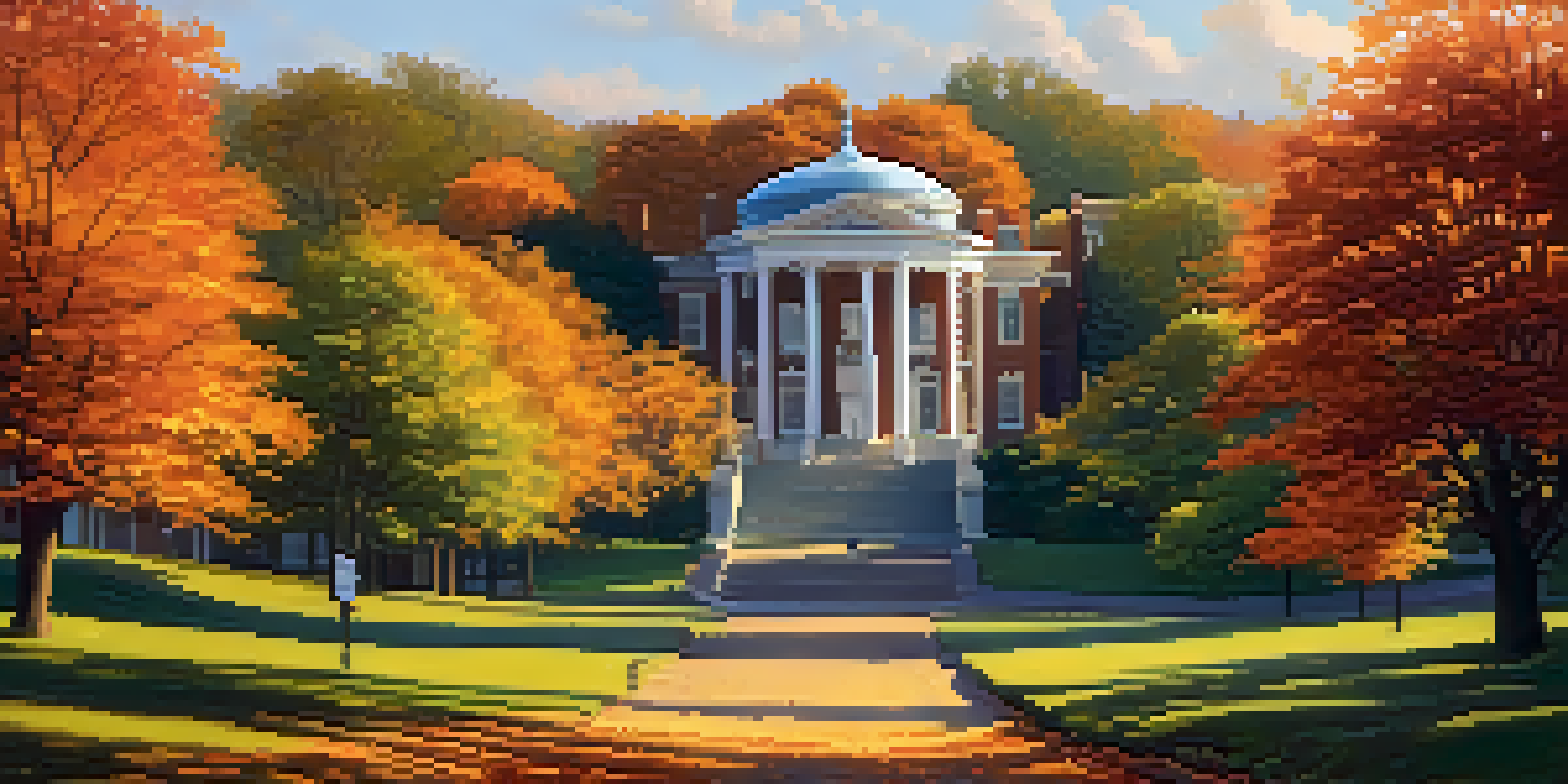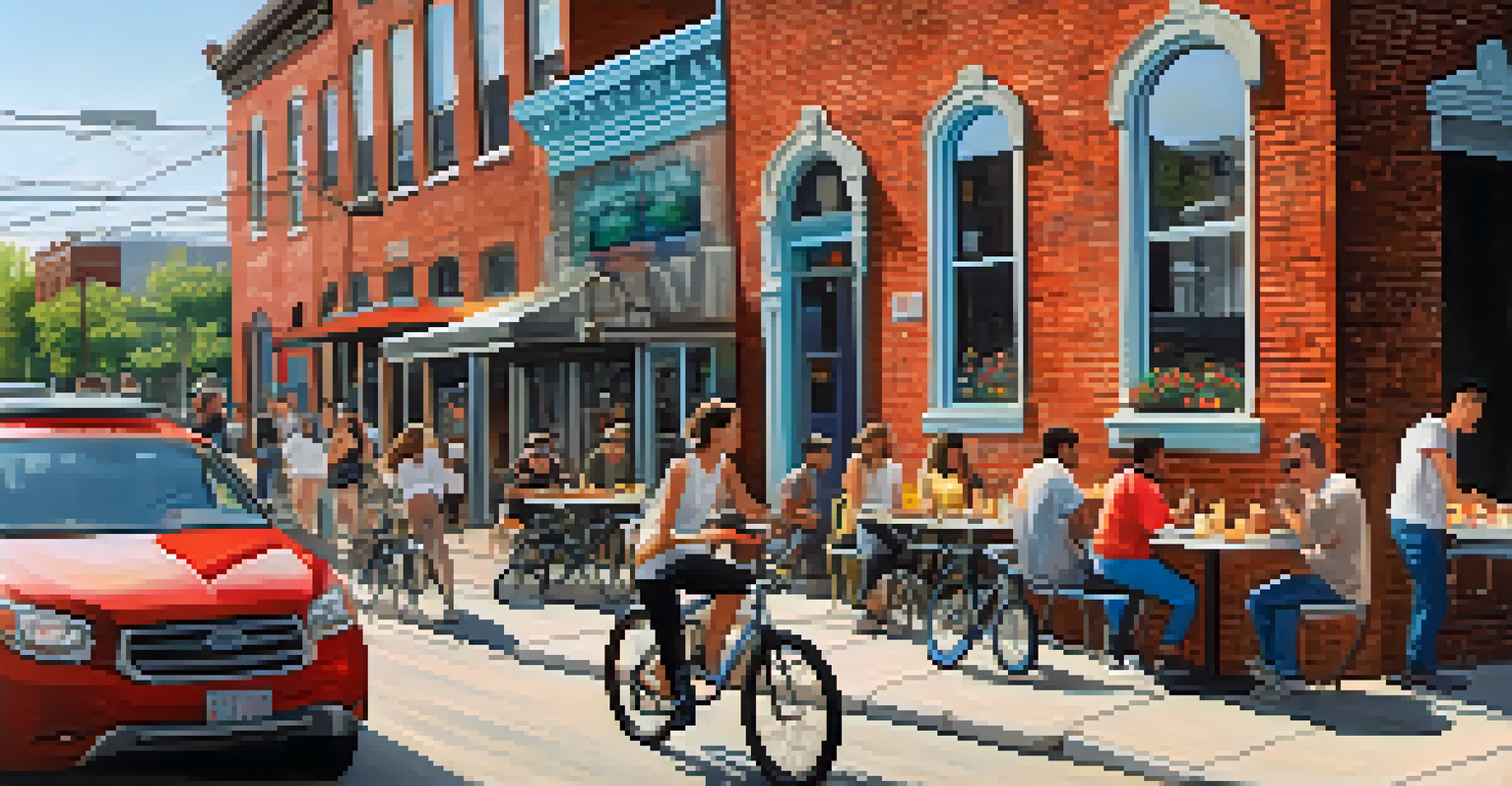Philadelphia's Urban Landscape: A Blend of Old and New

A Historical Overview of Philadelphia's Architecture
Philadelphia's architectural history is a captivating tapestry woven with colonial charm and modern innovation. From the iconic Independence Hall to the towering Liberty Place, the city showcases a rich legacy that dates back to its founding in 1682. The juxtaposition of historical landmarks with contemporary structures creates a visual dialogue, reflecting the city's evolution.
Philadelphia has always been a city of neighborhoods, where the past meets the present.
As you stroll through the streets, it's easy to spot the elegant Georgian and Federal-style buildings that tell tales of America's past. These structures not only serve as reminders of Philadelphia's role in the nation's history but also contribute to its unique urban character. The preservation of these buildings highlights the city's dedication to maintaining its heritage amidst rapid urbanization.
Moreover, Philadelphia's architecture is an ongoing story, with new developments continuously shaping the skyline. The blend of old and new is not just a visual spectacle; it's a celebration of Philadelphia's identity, where history and modernity coexist and enrich the urban experience.
Key Neighborhoods: Where Tradition Meets Innovation
Philadelphia's neighborhoods are distinct microcosms, each embodying its unique blend of tradition and innovation. Take Old City, for instance, where cobblestone streets lined with art galleries and trendy cafés coexist with historical sites like the Liberty Bell. This area exemplifies how the past can inspire a vibrant present, making it a must-visit for both locals and tourists.

In contrast, the emerging neighborhood of Fishtown showcases a more contemporary vibe with its eclectic mix of modern homes, breweries, and music venues. Here, the spirit of innovation thrives, attracting a younger demographic eager to contribute to the city's cultural tapestry. Fishtown's transformation is a testament to Philadelphia's ability to adapt and grow while honoring its roots.
Philadelphia: A Blend of Old and New
The city’s architecture and neighborhoods showcase a rich tapestry of historical landmarks and modern innovations.
As these neighborhoods evolve, they maintain a sense of community that reflects Philadelphia's core values. The interaction between old establishments and new enterprises fosters a dynamic atmosphere, inviting everyone to explore the diverse offerings of the city.
Public Art: A Canvas of Cultural Expression
Philadelphia's urban landscape is adorned with public art that speaks to the city's rich cultural heritage and vibrant creativity. Murals can be found on almost every corner, transforming blank walls into stunning stories that reflect the community's identity. This dedication to public art not only beautifies the city but also engages residents and visitors alike.
Art is the most beautiful of all lies; it is the only way we can express what we feel.
The Mural Arts Philadelphia program has played a pivotal role in this artistic revolution, commissioning thousands of murals across the city. These artworks often address social issues or celebrate the city's diverse history, making them more than just visual attractions. They provide a platform for dialogue and foster a sense of belonging among Philadelphians.
Public art in Philadelphia serves as a reminder that creativity can thrive in urban spaces. The fusion of historical significance with contemporary artistry creates a unique environment where every street tells a story, inviting exploration and appreciation from all who visit.
Green Spaces: Nature Amidst the Urban Hustle
In the heart of Philadelphia's bustling urban environment, green spaces provide a refreshing escape from the concrete jungle. Parks like Fairmount Park and Rittenhouse Square offer residents and visitors a chance to unwind among nature's beauty. These oases not only enhance the city's aesthetic but also promote well-being and community interaction.
Fairmount Park, one of the largest urban parks in the country, features miles of trails, gardens, and even historic mansions. It's a perfect spot for picnics, jogging, or simply enjoying a quiet moment in nature. The park's rich biodiversity and scenic landscapes make it a cherished part of Philadelphia's urban fabric.
Vibrant Public Art Scene
Philadelphia's public art, particularly murals, reflects its cultural heritage and fosters community engagement.
Additionally, smaller parks and community gardens scattered throughout the city foster a sense of community and environmental stewardship. These green spaces encourage outdoor activities and provide vital habitats for wildlife, reminding us that nature can coexist harmoniously with urban life.
Transportation: Navigating the Old and New
Philadelphia's transportation system is a fascinating blend of traditional and modern methods, making it accessible for all. The iconic SEPTA system includes buses, trolleys, and trains that link historical districts with new developments. This efficient network allows residents and visitors to explore the city's diverse offerings without the hassle of traffic.
Walking and biking are also popular ways to navigate Philadelphia, thanks to its pedestrian-friendly streets and growing bike lane infrastructure. The Schuylkill River Trail, for example, offers a scenic route for cyclists and joggers while providing stunning views of the skyline. This emphasis on alternative transportation methods reflects the city's commitment to sustainability and healthy living.
Moreover, the recent introduction of ride-sharing services and electric scooters has further enriched the transportation landscape. These modern options cater to the needs of a tech-savvy population and make it easier than ever to experience the unique blend of old and new that Philadelphia has to offer.
Culinary Scene: A Taste of Tradition and Innovation
Philadelphia's culinary scene is a delicious reflection of its urban landscape, blending traditional flavors with innovative techniques. The city is renowned for its iconic cheesesteaks and soft pretzels, which are staples that connect residents to their heritage. Yet, the food scene also embraces modernity with a plethora of farm-to-table restaurants, food trucks, and international cuisines.
Neighborhoods like South Philadelphia are famous for their authentic Italian eateries, while areas like Center City showcase trendy bistros and pop-up dining experiences. This culinary diversity not only satisfies a range of palates but also tells the story of the city’s immigrant history and its evolving identity.
Culinary Diversity and Innovation
The culinary scene in Philadelphia merges traditional flavors with modern techniques, celebrating the city's diverse cultural influences.
As chefs experiment with fusion cuisine and embrace local ingredients, Philadelphia's food landscape continues to thrive. This blend of tradition and innovation ensures that every meal in the city is a celebration of its rich cultural tapestry.
Cultural Events: Celebrating the Old and New
Philadelphia is a vibrant hub for cultural events that celebrate both its historical significance and modern creativity. Annual events like the Philadelphia Folk Festival and the Philadelphia Film Festival showcase the city’s rich artistic heritage while attracting new talent. These gatherings foster a sense of community and highlight the diverse voices that contribute to Philadelphia's cultural landscape.
The city's museums, such as the Philadelphia Museum of Art and the African American Museum, regularly host exhibitions and programs that connect the past with the present. These initiatives not only educate visitors about the city’s history but also encourage dialogue about contemporary issues, making art a powerful tool for social change.

With street fairs, concerts, and art walks happening year-round, there’s always something to celebrate in Philadelphia. This dynamic cultural scene invites everyone to engage with the city’s rich heritage while embracing the innovations that shape its future.